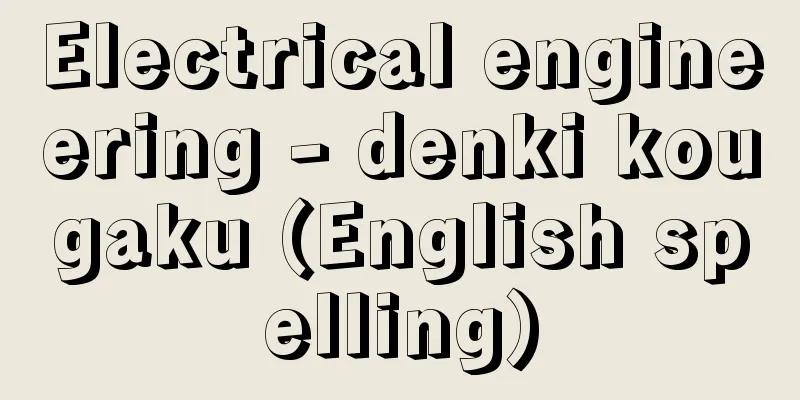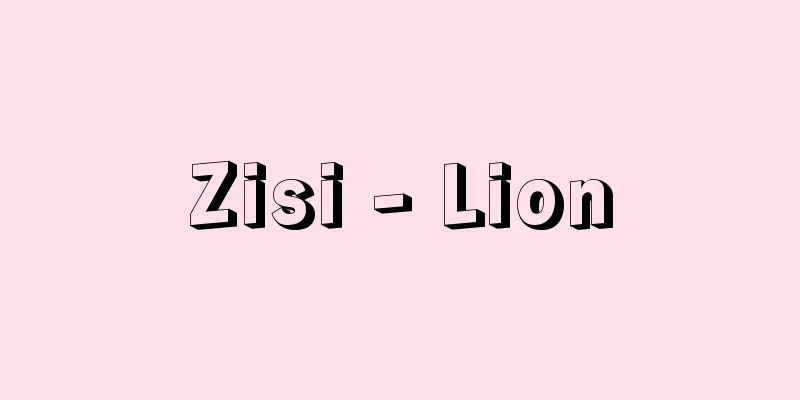Water resources

|
Water that can be used for human life, production activities, etc. Water is used for daily life (domestic water: drinking, cooking, washing, bathing, toilets, etc.; urban activity water: business, office, public use, etc.), industrial water (boiler, raw material, product processing, cleaning, cooling, etc.), agricultural water (paddy field and field irrigation, livestock, etc.), hydroelectric power generation, etc. Water resources used include river water, lake water, spring water, groundwater, etc. The source of water resources is precipitation, and water resources are renewable resources. [Noboru Ikawa] Japan's Water ResourcesIn Japan, river water and groundwater are the main water resources. Japanese rivers have small drainage basins and steep slopes, and river flow increases when there is rain or snowmelt, and decreases when there is no rain or snowmelt, and fluctuates depending on the conditions of rain or snowmelt. The average annual precipitation in Japan is 1,690 mm, which is about twice the average annual precipitation in the world (on land). Although precipitation occurs throughout the year, precipitation is heavy during the rainy season, typhoon season, and snowfall season, and because of seasonal changes, the annual river flow rate fluctuates. Therefore, in order to use river water stably throughout the year, it is necessary to build dams, store water when the flow rate is high, and release it when the flow rate is low to make up for the shortage. When using river water, permission (water rights) from the river administrator (nation or prefecture) is required. If groundwater is pumped excessively, the groundwater level will drop, it will dry up, or land subsidence will occur, so it is necessary to manage it appropriately. In some areas, pumping of groundwater is restricted. Although the amounts are small, desalinization of seawater, rainwater, and treated sewage water are also used. [Noboru Ikawa] Water Use in JapanIn Japan, during the Yayoi period, rice paddy cultivation was practiced in areas where water was easily obtained. From the Kofun period onwards, irrigation reservoirs and irrigation channels were built to develop the paddy fields. During the Edo period, irrigation projects such as building dams in rivers and digging irrigation channels to develop new rice fields were carried out all over the country. Waterworks that used rivers and springs as water sources were laid in Tokyo (Edo), Mito, Kanazawa, Nagoya, Kagoshima and other places. The development of irrigation water continued after the Meiji period through the construction of irrigation dams and the installation of pumping stations. A modern waterworks system was laid in Yokohama in 1887 (Meiji 20), followed by Hakodate, Nagasaki, Osaka, Hiroshima, Tokyo, Kobe, and other cities during the Meiji period. These waterworks used rivers as their water source, and waterworks dams were built in Nagasaki and Kobe. The construction of waterworks continued after the Taisho period. Hydroelectric power generation began in 1890. After the Taisho period, dams for power generation were built and hydroelectric development was promoted. The demand for industrial water and water for daily life in cities increased due to the development of industry, the concentration of population in cities, and changes in lifestyles from the 1950s onwards, and water resource development was promoted through the construction of dams, etc. Since around 1997 (Heisei 9), water usage has been decreasing due to the development of water-saving technology, changes in industrial structure, slowing economic growth, and a decrease in the area of rice cultivation. According to the 2012 edition of "Japan's Water Resources" (Water Resources Department, Water Management and Disaster Management Bureau, Ministry of Land, Infrastructure, Transport and Tourism), the amount of water used nationwide in 2009 was approximately 81.5 billion cubic meters (91% of the amount used in 1997), of which 67% was used for agricultural purposes, 19% for domestic use, and 14% for industrial use. River water accounted for 88% of the water source, and groundwater for 12%. The amount of hydroelectric power generated in fiscal 2010 was approximately 90.7 billion kilowatt-hours, accounting for 7.9% of the total amount of electricity generated. In recent years, small-scale hydroelectric power generation using irrigation channels and other sources has been attracting attention as a form of renewable energy. [Noboru Ikawa] World Water ResourcesThe total amount of water on Earth is said to be 1,386 million cubic kilometers. Up to 96.5% of this is seawater. The next largest proportion is ice and snow (24.06 million cubic kilometers), of which nearly 90% (21.6 million cubic kilometers) is in Antarctica. This is followed by groundwater (23.4 million cubic kilometers) and lake water (180,000 cubic kilometers). Much of the groundwater and lake water is salty, and freshwater, which is the most valuable water resource on Earth, amounts to 35 million cubic kilometers, accounting for only 2.5% of the total. This includes water contained in ice and snow, permafrost, and groundwater that is too deep to be used, or that is trapped in strata, so river water, which is the key to water utilization, and usable groundwater are limited. The amount of precipitation that provides water for rivers and other water sources varies greatly from region to region, and seasonal variations throughout the year also vary greatly from place to place. This has led to differences in agricultural methods and lifestyles in different regions due to differences in climate, and has influenced the development and rise and fall of civilizations. For example, in ancient Egypt, where the annual flooding of the Nile River was incorporated into the agricultural calendar, natural disasters were seen as an opportunity to irrigate and replenish the soil, and were linked to water use. Astronomical observations were developed to accurately predict flood times, and as a result, calendars were developed. In the ancient Roman Empire, aqueducts (Roman aqueducts) were built to bring water to the capital Rome, which had a large population. Aqueducts, which are part of these aqueducts, still remain today, demonstrating the high level of construction technology at the time. Traces of advanced water utilization facilities can also be found in Petra, a ruin left in the desert, and Machu Picchu, known as the "city in the sky." Since the beginning of the 20th century, the construction of dams and water supply systems has progressed in developed countries, and restrictions and limitations on water use have been reduced. However, water pollution problems continue to occur repeatedly, although the direct causes have changed. On the other hand, there are still many people, especially in developing countries, who do not have access to sufficient clean water. The number of people who do not have access to safe drinking water accounts for a significant portion of the world's population. The more extensive the water resource development that is undertaken to overcome these problems, the greater the possibility of causing environmental destruction and ecosystem problems. Furthermore, the world's water resource problems are endless, with international conflicts occurring over water. Against this backdrop of problems and issues, the World Water Council (WWC) was established in 1996, primarily by international organizations such as the International Bank for Reconstruction and Development (IBRD, commonly known as the World Bank) and the United Nations Educational, Scientific and Cultural Organization (UNESCO). Since 1997, the World Water Council has been held every three years to discuss global water issues. [Kato Koji] "Civil Engineering Series 24: Case Study Water Resources" by Nakazawa Kazuhito et al. (1978, Shokokusha)" ▽ "The Science of Water Resources" by Nakazawa Kazuhito (1991, Asakura Shoten)" ▽ "Hydrology and Water Resources Handbook" edited by the Japan Society of Hydrology and Water Resources (1997, Asakura Shoten)" ▽ "New National Comprehensive Water Resources Plan" edited by the Water Resources Department of the National Land Agency (1999, Printing Bureau of the Ministry of Finance)" ▽ "World Water Vision: River and Water Committee edited: World Water Vision (2001, Sankaido)" ▽ "Japan's Water Resources" edited by the Water Resources Department of the Land and Water Bureau of the Ministry of Land, Infrastructure, Transport and Tourism, various editions (Printing Bureau of the Ministry of Finance)" [Reference items] | | | | | |Water | | | | | | | | |©Shogakukan "> Comprehensive water resource utilization system Source: Shogakukan Encyclopedia Nipponica About Encyclopedia Nipponica Information | Legend |
|
人の生活、生産活動などのために利用可能な水。水は生活用水(家庭用水:飲料用、調理用、洗濯用、風呂用、トイレ用など、都市活動用水:営業用、事業所用、公共用など)、工業用水(ボイラー用、原料用、製品処理用、洗浄用、冷却用など)、農業用水(水田・畑灌漑(かんがい)用、畜産用など)、水力発電などに使用される。水資源として河川水、湖沼水、湧水(ゆうすい)、地下水などが使用される。水資源の源は降水であり、水資源は再生可能な資源である。 [鮏川 登] 日本の水資源日本では水資源として、おもに河川水と地下水が使用されている。日本の河川は流域が小さく、勾配(こうばい)が急で、河川流量は降雨や融雪があると多くなり、ないと少なくなり、降雨や融雪の状況に応じて変動する。日本の年平均降水量は1690ミリメートルで、世界(陸域)の年平均降水量の約2倍と多く、また降水は年間を通じてあるが、降水量は梅雨期、台風期、降雪期に多く、季節的に変化するために、年間の河川流量は変動する。そのため河川水を1年を通して安定して利用するためにはダムをつくり、流量が多いときに貯水し、少ないときに放流して不足分を補うことが必要になる。河川水を使用するときは河川管理者(国、都道府県)の許可(水利権)を得ることが必要である。地下水は過剰に揚水すると、地下水位が低下し、枯渇したり、地盤沈下を生じたりするので、適正に管理することが必要である。地下水の揚水が規制されている地域もある。量はわずかであるが、海水の淡水化、雨水や下水処理水の利用も行われている。 [鮏川 登] 日本の水利用日本では、弥生時代に水の得やすいところで水田稲作が行われた。古墳時代以降、水田開発のために灌漑用の溜池(ためいけ)や用水路などがつくられた。江戸時代には、新田開発のために河川に堰(せき)をつくり、用水路を開削するなどの灌漑事業が各地で実施された。東京(江戸)、水戸、金沢、名古屋、鹿児島などでは河川や湧泉(ゆうせん)を水源とする水道が敷設された。 明治時代以降も灌漑用ダムの建設、揚水機場の設置などにより灌漑用水の開発が進められた。1887年(明治20)に横浜で近代式水道が敷設されたのを始めとして、明治時代に函館(はこだて)、長崎、大阪、広島、東京、神戸などで近代式水道が敷設された。これらの水道は河川を水源とし、長崎、神戸では水道用のダムがつくられた。大正時代以降も水道の敷設が進められた。1890年に水力発電が始められた。大正時代以降には発電用のダムがつくられ、水力開発が進められた。昭和30年代以降の産業の発展と都市への人口集中の進展、生活様式の変化などにより都市における工業用水および生活用水の需要が増加し、ダム建設などによる水資源開発が進められた。1997年(平成9)ごろからは節水技術の進展、産業構造の転換、経済成長の鈍化、水稲作付面積の減少などにより水使用量は減少している。平成24年版「日本の水資源」(国土交通省水管理・国土保全局水資源部)によると、2009年(平成21)における全国の水使用量は約815億立方メートル(1997年の水使用量の91%)で、そのうち67%は農業用水、19%は生活用水、14%は工業用水として使用されている。水源は河川水が88%、地下水が12%である。水力発電の2010年度の発電電力量は約907億キロワット時で、全発電電力量の7.9%を占めている。近年は再生可能エネルギーの一つとして用水路などを利用した小規模な水力発電が注目されている。 [鮏川 登] 世界の水資源地球上の水の総量は13億8600万立方キロメートルとされる。そのうちの96.5%までが海水である。ついで大きな割合を占めるのが、氷雪(2406万立方キロメートル)であり、その90%近く(2160万立方キロメートル)は南極にある。地下水(2340万立方キロメートル)、湖水(18万立方キロメートル)がそれに続く。地下水、湖水には塩水等も多く、地球上の水のうち、水資源としてもっとも利用価値の高い淡水は3500万立方キロメートルで、全体の2.5%を占めるにすぎない。これには氷雪や凍土に含まれる水分、利用できないほど深い位置にあったり、地層内に閉じこめられたりしている地下水も含まれており、水利用の鍵(かぎ)となる河川水、利用可能な地下水は限られている。 河川水などの供給源となる降水量の多寡は、地域によって著しく異なり、年間を通しての季節による偏りも場所によって大きな違いがある。それが気候の違いによる農業形態の違いや地域ごとの生活様式の違いを生み、文明の発達・盛衰にも影響してきた側面がある。たとえば、ナイル川における毎年の氾濫(はんらん)を農業暦のなかに組み込んだ耕作をしていたとされる古代エジプトでは、一種の自然災害を土壌の供給・灌漑の機会ととらえ、利水に結び付けていた。氾濫時期を正確に予測するために天文観測が発達し、その結果、暦が発達したとされている。また古代ローマ帝国では、多くの人口を抱える首都ローマに上水を引くために水道(ローマ水道)が建設された。その一部である水道橋は当時の建設技術の高さを示しながら現在も残っている。砂漠に残された遺跡・ペトラや「天空の都市」とよばれるマチュ・ピチュにも高度な利水施設の痕跡(こんせき)がある。 20世紀に入ってからは、先進国ではダムの建設や上水道の敷設などが進み、水利用の制限・限定性は低くなってきている。とはいえ、水質汚染の問題は直接の原因を変えながらも繰り返し発生し続けている。 一方、開発途上国を中心に上水が十分に手に入らない人々は依然少なくない。安心して飲める飲料水が手に入らないという人々の数は世界人口のかなりの数を占めている。こうした問題を克服しようという水資源の開発が大規模であればあるほど、自然破壊や生態系の問題を引き起こす可能性も高い。また、水をめぐって国際紛争が引き起こされるなど、世界の水資源の問題は絶えない。 このような問題・課題を背景に1996年、国際復興開発銀行(IBRD。通称、世界銀行)と国連教育科学文化機関(UNESCO)の国際機関等が中心となり、世界水会議(WWC=World Water Council)が設立され、1997年より3年に一度、世界の水問題を議論する会議、世界水フォーラムが開催されている。 [加藤幸治] 『中澤弌仁他著『土木工学大系24 ケーススタディ水資源』(1978・彰国社)』▽『中澤弌仁著『水資源の科学』(1991・朝倉書店)』▽『水文・水資源学会編『水文・水資源ハンドブック』(1997・朝倉書店)』▽『国土庁水資源部編『新しい全国総合水資源計画』(1999・大蔵省印刷局)』▽『世界水ビジョン川と水委員会編『世界水ビジョン』(2001・山海堂)』▽『国土交通省土地・水資源局水資源部編『日本の水資源』各年版(財務省印刷局)』 [参照項目] | | | | | | | | | | | | | | |©Shogakukan"> 水資源の総合利用体系 出典 小学館 日本大百科全書(ニッポニカ)日本大百科全書(ニッポニカ)について 情報 | 凡例 |
<<: Water Resources Development Public Corporation
>>: Silver in water - Mizushioiregin
Recommend
West Highland white terrier [breed] (English spelling)
A domestic dog that originated in the UK. It is a ...
Pernet-Ducher, J.
...This rose had the year-round flowering charact...
Secondary cosmic rays
...A general term for high-energy (10 8 eV or mor...
Tyson, Mike
Born June 30, 1966. Brooklyn, New York. American p...
The Watchtower
The Watchtower Bible is a popular periodical pamph...
Executive branch - gyoseifu
The term "administrative agency" refers ...
Homunculus
...The first capuchin monkey, Dolichocebus , was ...
Loomis Shijimi (tailless bushblue)
A butterfly belonging to the family Lycaenidae in...
Explosion earthquake
Andesitic volcanoes exhibit explosive eruptions, a...
Square - Heihou
The product of a number with itself is called the...
packhawaj (English spelling)
...It is sometimes paired with a drum called a ba...
Martens, C. (English spelling) Martens C
… [art] Painting began with documentary paintings...
Value formation
…However, while in the circulation process, the s...
One-stage revolution theory
...On the other hand, non-Communist Marxists (the...
Entry side - Irigawa
A corridor between a zashiki room and a veranda. I...









